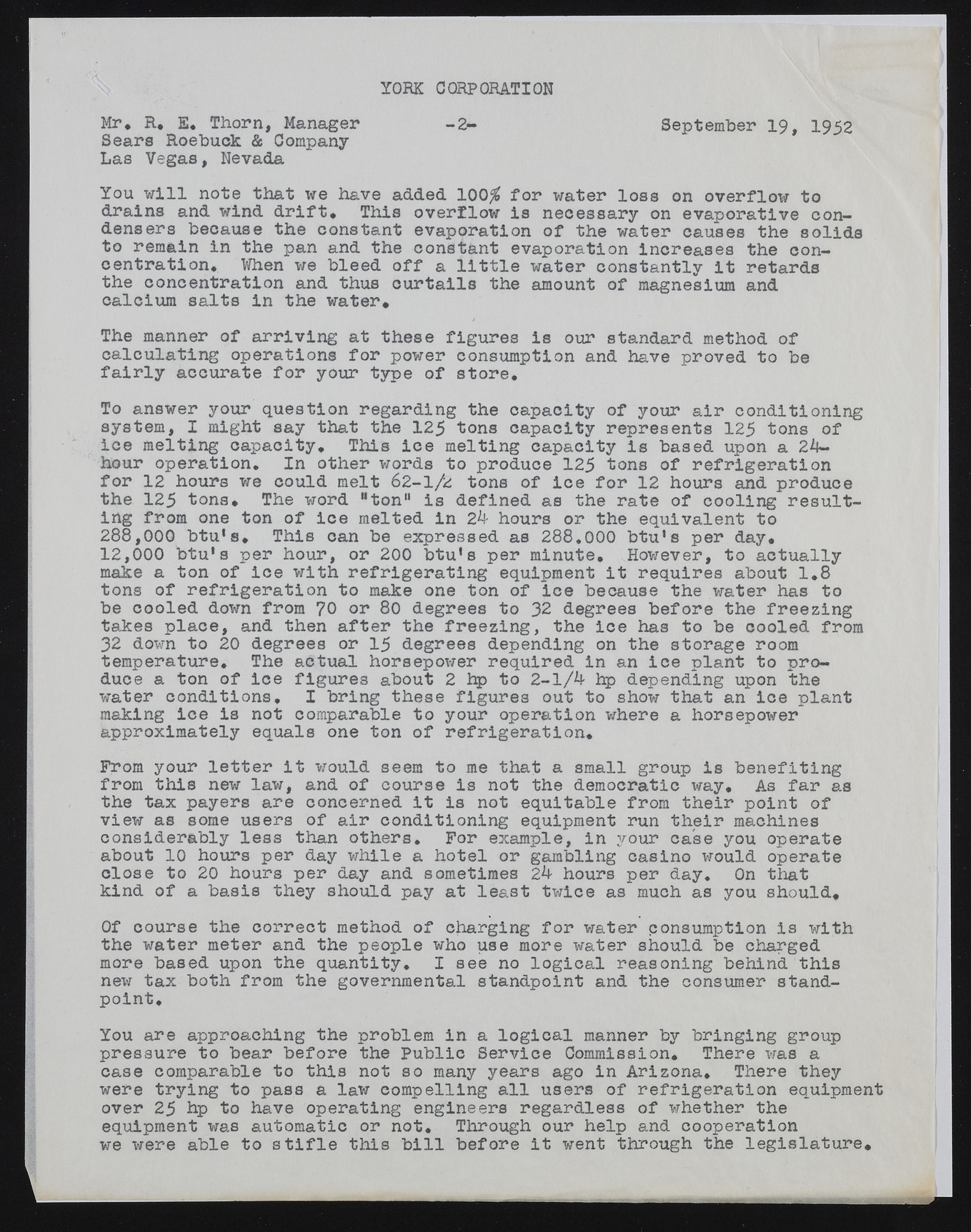Copyright & Fair-use Agreement
UNLV Special Collections provides copies of materials to facilitate private study, scholarship, or research. Material not in the public domain may be used according to fair use of copyrighted materials as defined by copyright law. Please cite us.
Please note that UNLV may not own the copyright to these materials and cannot provide permission to publish or distribute materials when UNLV is not the copyright holder. The user is solely responsible for determining the copyright status of materials and obtaining permission to use material from the copyright holder and for determining whether any permissions relating to any other rights are necessary for the intended use, and for obtaining all required permissions beyond that allowed by fair use.
Read more about our reproduction and use policy.
I agree.Information
Digital ID
Permalink
Details
More Info
Rights
Digital Provenance
Publisher
Transcription
YORK CQRPORATION Mr* R. E. Thorn, Manager -2*- September 19, 1952 Sears Roebuck & Company Las Vegas, Nevada You will note that we have added 100$ for water loss on overflow to drains and wind drift* This overflow is necessary on evaporative condensers because the constant evaporation of the water causes the solids to remain in the pan and the constant evaporation increases the concentration. When we bleed off a little water constantly it retards the concentration and thus curtails the amount of magnesium and calcium salts in the water* The manner of arriving at these figures is our standard method of calculating operations for power consumption and have proved to be fairly accurate for your type of store. To answer your question regarding the capacity of your air conditioning system, I might say that the 125 tons capacity represents 125 tons of ice melting capacity. This ice melting capacity is based upon a 24- hour operation. In other words to produce 125 tons of refrigeration for 12 hours we could melt 62-1/2 tons of ice for 12 hours and produce the 125 tons. The word "ton" is defined as the rate of cooling resulting from one ton of ice melted in 24- hours or the equivalent to 288.000 btu's. This can be expressed as 288.000 btu's per day. 12.000 btu's per hour, or 200 btu's per minute. However, to actually make a ton of ice with refrigerating equipment it requires about 1.8 tons of refrigeration to make one ton of ice because the water has to be cooled down from 70 or 80 degrees to 32 degrees before the freezing takes place, and then after the freezing, the ice has to be cooled from 32 down to 20 degrees or 15 degrees depending on the storage room temperature. The actual horsepower required in an ice plant to produce a ton of ice figures about 2 hp to 2-1/4- hp depending upon the water conditions. I bring these figures out to show that an ice plant making ice is not comparable to your operation where a horsepower approximately equals one ton of refrigeration. Prom your letter it would seem to me that a small group is benefiting from this new law, and of course is not the democratic way. As far as the tax payers are concerned it is not equitable from their point of view as some users of air conditioning equipment run their machines considerably less than others. For example, in your cake you operate about 10 hours per day while a hotel or gambling casino would operate close to 20 hours per day and sometimes 24- hours per day. On that kind of a basis they should pay at least twice as much as you should* Of course the correct method of charging for water consumption is with the water meter and the people who use more water should be charged more based upon the quantity. I see no logical reasoning behind this new tax both from the governmental standpoint and the consumer standpoint. You are approaching the problem in a logical manner by bringing group pressure to bear before the Public Service Commission* There was a case comparable to this not so many years ago in Arizona. There they were trying to pass a law compelling all users of refrigeration equipment over 25 hp to have operating engineers regardless of whether the equipment was automatic or not. Through our help and cooperation we were able to stifle this bill before it went through the legislature*

